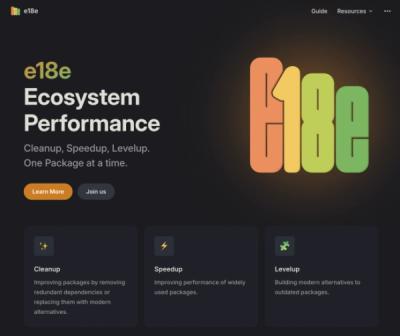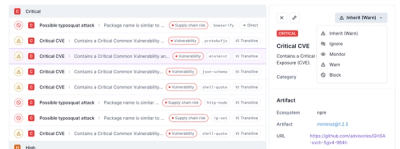
Research
Security News
Malicious npm Package Typosquats react-login-page to Deploy Keylogger
Socket researchers unpack a typosquatting package with malicious code that logs keystrokes and exfiltrates sensitive data to a remote server.
@realm/react
Advanced tools
Readme
Build better apps, faster.
Setting up Realm in a React Native application has historically been complex. Re-rendering of components when objects in the database change requires manually adding and removing listeners, which produce a lot of boilerplate code and is error-prone (if listeners properly removed on unmount). This library alleviates that by providing React hooks which return Realm data that is state aware. As a consequence, any change to the Realm data will cause components using the hook to re-render.
Documentation for @realm/react and Realm can be found at docs.mongodb.org.
This library requires react-native >= 0.59 and realm >= 11
npm:
npm install realm @realm/react
yarn:
yarn add realm @realm/react
Here is a simple task manager application written with Realm React. Copy into a React Native application and give it a try!
import React, { useState } from "react";
import { SafeAreaView, View, Text, TextInput, FlatList, Pressable } from "react-native";
import { Realm, createRealmContext } from '@realm/react'
class Task extends Realm.Object {
_id!: Realm.BSON.ObjectId;
description!: string;
isComplete!: boolean;
createdAt!: Date;
static generate(description: string) {
return {
_id: new Realm.BSON.ObjectId(),
description,
createdAt: new Date(),
};
}
static schema = {
name: 'Task',
primaryKey: '_id',
properties: {
_id: 'objectId',
description: 'string',
isComplete: { type: 'bool', default: false },
createdAt: 'date'
},
};
}
const { RealmProvider, useRealm, useQuery } = createRealmContext({ schema: [Task] })
export default function AppWrapper() {
return (
<RealmProvider><TaskApp /></RealmProvider>
)
}
function TaskApp() {
const realm = useRealm();
const tasks = useQuery(Task);
const [newDescription, setNewDescription] = useState("")
return (
<SafeAreaView>
<View style={{ flexDirection: 'row', justifyContent: 'center', margin: 10 }}>
<TextInput
value={newDescription}
placeholder="Enter new task description"
onChangeText={setNewDescription}
/>
<Pressable
onPress={() => {
realm.write(() => {
realm.create("Task", Task.generate(newDescription));
});
setNewDescription("")
}}><Text>➕</Text></Pressable>
</View>
<FlatList data={tasks.sorted("createdAt")} keyExtractor={(item) => item._id.toHexString()} renderItem={({ item }) => {
return (
<View style={{ flexDirection: 'row', justifyContent: 'center', margin: 10 }}>
<Pressable
onPress={() =>
realm.write(() => {
item.isComplete = !item.isComplete
})
}><Text>{item.isComplete ? "✅" : "☑️"}</Text></Pressable>
<Text style={{ paddingHorizontal: 10 }} >{item.description}</Text>
<Pressable
onPress={() => {
realm.write(() => {
realm.delete(item)
})
}} ><Text>{"🗑️"}</Text></Pressable>
</View>
);
}} ></FlatList>
</SafeAreaView >
);
}
For a full fledged example, check out our templates.
Returns the instance of the Realm configured by createRealmContext and the RealmProvider. The following is an example of how to use this Hook to make a write transaction callback for a component.
// assume props contain item a Realm.Object
const Component = ({item}) => {
const realm = useRealm();
const toggleComplete = useCallback((item) => {
realm.write(() => {
item.isComplete = !item.isComplete
})
},[item, realm])
return (
<Pressable
onPress={() =>
realm.write(() => {
item.isComplete = !item.isComplete
})
}><Text>{item.isComplete ? "✅" : "☑️"}</Text>
</Pressable>
)
}
Returns Realm.Results from a given type. This Hook will update on any changes to any Object in the Collection and return an empty array if the Collection is empty.
The result of this can be consumed directly by the data argument of any React Native VirtualizedList or FlatList. If the component used for the list's renderItem prop is wrapped with React.Memo, then only the modified object will re-render.
const Component = () => {
// ObjectClass is a class extending Realm.Object, which should have been provided in the Realm Config.
// It is also possible to use the model's name as a string ( ex. "Object" ) if you are not using class based models.
const collection = useQuery(ObjectClass);
// The methods `sorted` and `filtered` should be wrapped in a useMemo.
const sortedCollection = useMemo(() => collection.sorted(), [collection]);
return (
<FlatList data={sortedCollection} renderItem={({ item }) => <Object item={item}/>
)
}
Returns a Realm.Object for a given type and primary key. The Hook will update on any changes to the properties on the returned Object and return null if it either doesn't exist or has been deleted.
const Component = ({someId}) => {
// ObjectClass is a class extending Realm.Object, which should have been provided in the Realm Config.
// It is also possible to use the model's name as a string ( ex. "Object" ) if you are not using class based models.
const object = useObject(ObjectClass, someId);
return (
<View>
<Text>{object.name}</Text>
</View>
)
}
To get started with @realm/react, one must create a Context object with createRealmContext. The Context object will contain a Realm Context Provider, which will have an open Realm as its context, and a set of Hooks that access the Realm Context.
The structure of the Context object is:
{
RealmProvider, // Wrapper for your application to enable usage of hooks
useRealm, // Hook to access the configured Realm
useQuery, // Hook to access collections of Realm objects
useObject, // Hook to access a single Realm object by primary key
}
The configuration for the Realm context can be given as an object argument to createRealmContext or be set directly on the RealmProvider props. The props set on RealmProvider will be merged with those provided to createRealmContext, with the props taking priority. A Realm will be opened with this merged configuration when the Realm Context Provider is rendered. A fallback component can optionally be rendered until the Realm is opened. This is useful for projects using Realm Sync.
Here is an example of how to setup Realm React with a Task model:
import {createRealmContext} from '@realm/react';
const myRealmConfig = { schema: [Task, User, /*...*/]};
const { RealmProvider, useRealm, useObject, useQuery } = createRealmContext(myRealmConfig);
const AppWrapper = () => {
return (
<RealmProvider>
<App/>
<RealmProvider>
)
}
createRealmContext can be called multiple times if your app requires more than one Realm. In that case, you would have multiple RealmProviders that wrap your app and must use the hooks from the context you wish to access.
const { RealmProvider: PublicRealmProvider, useRealm: usePublicRealm, useObject: usePublicObject, useQuery: usePublicQuery } = createRealmContext(publicConfig);
const { RealmProvider: PrivateRealmProvider, useRealm: usePrivateRealm, useObject: usePrivateObject, useQuery: usePrivateQuery } = createRealmContext(privateConfig);
It is also possible to call it without any Config; in the case that you want to do all your configuration through the RealmProvider props.
In the example above, we used the RealmProvider without any props. It is, however, possible to configure the Realm through props on the RealmProvider.
const AppWrapper = () => {
return (
<RealmProvider schema={[Task, User, /*...*/]} onFirstOpen={(realm) => {/*initialize realm with some data*/}}>
<App/>
<RealmProvider>
)
}
The RealmProvider also comes with a fallback prop that can be used for sync conifigurations. It can take time for larger datasets to sync, especially if it's the first time. In that case, it is recommended to provide a loading component as a fallback.
const AppWrapper = () => {
return (
<RealmProvider fallback={<Loading/>} >
<App/>
<RealmProvider>
)
}
In some cases, it may be necessary to access the configured Realm from outside of the RealmProvider, for instance, implementing a client reset fallback. This can be done by creating a ref with useRef and setting the realmRef property of RealmProvider.
const AppWrapper = () => {
const realmRef = useRef<Realm|null>(null)
return (
<RealmProvider realmRef={realmRef}>
<App/>
<RealmProvider>
)
}
It is possible to update the realm configuration by setting props on the RealmProvider. The RealmProvider takes props for all possible realm configuration properties.
For example, one could setup the sync configuration based on a user state:
const [user, setUser] = useState()
//... some logic to get user state
<RealmProvider sync={{ user, partition }}>
useApp and the AppProviderThe useApp hook can be used to access your Realm App instance as long as the AppProvider wraps your application. This should be done outside of your RealmProvider.
AppProvider usage:
import { AppProvider } from '@realm/react'
//...
// Wrap your RealmProvider with the AppProvider and provide an appId
<AppProvider id={appId}>
<RealmProvider sync={{user, flexible: true}}>
//...
</RealmProvider>
</AppProvider>
useApp usage:
// Access the app instance using the useApp hook
import { useApp } from '@realm/react'
const SomeComponent = () => {
const app = useApp();
//...
}
It is also possible to receive a reference to the app outside of the AppProvider, through the appRef property. This must be set to a React reference returned from useRef.
const AppWrapper = () => {
const appRef = useRef<Realm.App|null>(null)
return (
<AppProvider appRef={appRef}>
<App/>
<AppProvider>
)
}
useUser and the UserProviderWith the introduction of the UserProvider, the user can be automatically populated into the underlying Realm configuration. The fallback property can be used to provide a login component.
The child components will be rendered as soon as a user has authenticated. On logout, the fallback will be displayed again.
UserProvider usage:
import { AppProvider, UserProvider } from '@realm/react'
//...
<AppProvider id={appId}>
<UserProvider fallback={LoginComponent}>
{/* After login, user will be automatically populated in realm configuration */}
<RealmProvider sync={{flexible: true}}>
//...
</RealmProvider>
</UserProvider>
</AppProvider>
useUser usage:
// Access the app instance using the useApp hook
import { useUser } from '@realm/react'
const SomeComponent = () => {
const user = useUser();
//...
}
FAQs
Unknown package
We found that @realm/react demonstrated a healthy version release cadence and project activity because the last version was released less than a year ago. It has 6 open source maintainers collaborating on the project.
Did you know?

Socket for GitHub automatically highlights issues in each pull request and monitors the health of all your open source dependencies. Discover the contents of your packages and block harmful activity before you install or update your dependencies.

Research
Security News
Socket researchers unpack a typosquatting package with malicious code that logs keystrokes and exfiltrates sensitive data to a remote server.

Security News
The JavaScript community has launched the e18e initiative to improve ecosystem performance by cleaning up dependency trees, speeding up critical parts of the ecosystem, and documenting lighter alternatives to established tools.

Product
Socket now supports four distinct alert actions instead of the previous two, and alert triaging allows users to override the actions taken for all individual alerts.